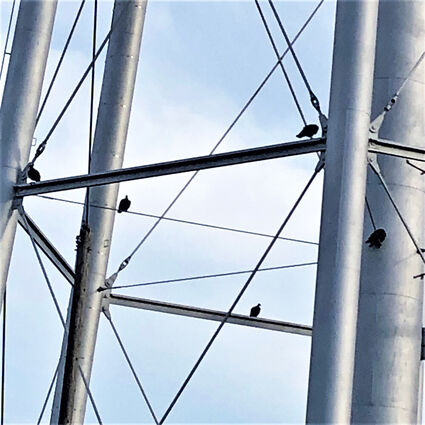They're back... Turkey vultures make annual visit to Chinook
August 3, 2022

This closeup of the girders and guywires that support Chinook's newer water tower shows part of the flock of about 40 turkey vultures that drop in to rest from time to time during the summer. Originally confined to the south, the turkey vultures have expanded to all 48 contiguous states in the U.S. Increasing numbers have been showing up here each summer.
Alert "Journal" readers will recall a story I wrote back in 2017 about turkey vultures-the huge black birds often seen gliding over Chinook and its environs. I first noticed them a few years ago on the 'new water tower' in Chinook at the southeast corner of town. On a recent walk just before sundown I was in that area and saw a huge number of 'black dots' on the water tower from the railings around the tank to the lower beams and guy wires that stabilize the tower. Up close I counted about 20 of the scavengers peacefully perched on the tower.
Linda Sharples, who lives near the tower, was in her yard working when I passed by. I asked about the birds and she said, "Oh I've seen as many as 40 at one time on the tower. Just before sundown they leave in small groups and head west." She was not sure where they actually roosted.
In the previous story in 2017 Lee Miller, whose backyard used to be the main hangout for the birds in the summer, told me that some of the birds that left his yard were still roosting in an evergreen tree in front of Fred and Rita Langford's house on Illinois Street.
I asked Fred Langford if they birds still roosted near his place and he said, "About a dozen roost there and some also across the street in another evergreen." A sizeable number the flock must have yet other places they are spending the night (one year some around a small shed in a little pasture on 7th Street East, west of the county maintenance shop).
Until about a decade ago the birds were considered a 'southern bird' and were never seen this far north. Adaptations to changes in the environment have resulted in their now being seen in all 48 contiguous states of the country. Their bald heads and necks allow them to poke into carrion to feed. Strong stomach acids make them resistant to diseases that would be found on a dead carcass. Their six-foot wing span makes them noticeable gliding in the sky.
Lee Miller believes the turkey vultures first came to this area after a large kill of deer increased the availability of food. A representative at Montana Fish, Wildlife and Parks said another theory is that after DDT was banned there was a better survival rate of hatchlings. The increased number of birds meant they moved out of the south to find more places to live and hunt for food.
Fred Langford said of the vultures, "They are the ugliest bird around but I love to watch them effortlessly soar on the wind currents." They are fun to watch and their numbers seem to be growing.

